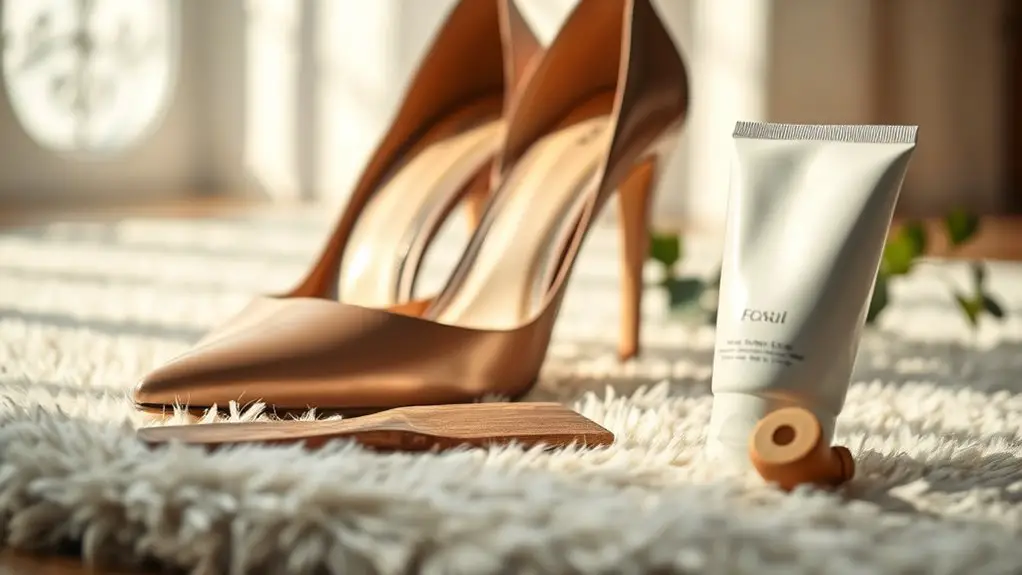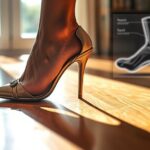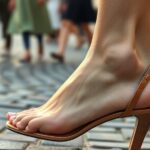To prevent corns and calluses from high heels, start by choosing shoes that fit properly and are made from quality, breathable materials. Limit the time you wear heels to two to three hours and use cushioned inserts for added comfort. Maintain proper foot hygiene, including daily washing and moisturizing. Incorporate stretches into your routine to promote flexibility. Pay attention to your gait, ensuring an even weight distribution. There’s much more to explore about optimizing foot health in heels.
Choose the Right Fit
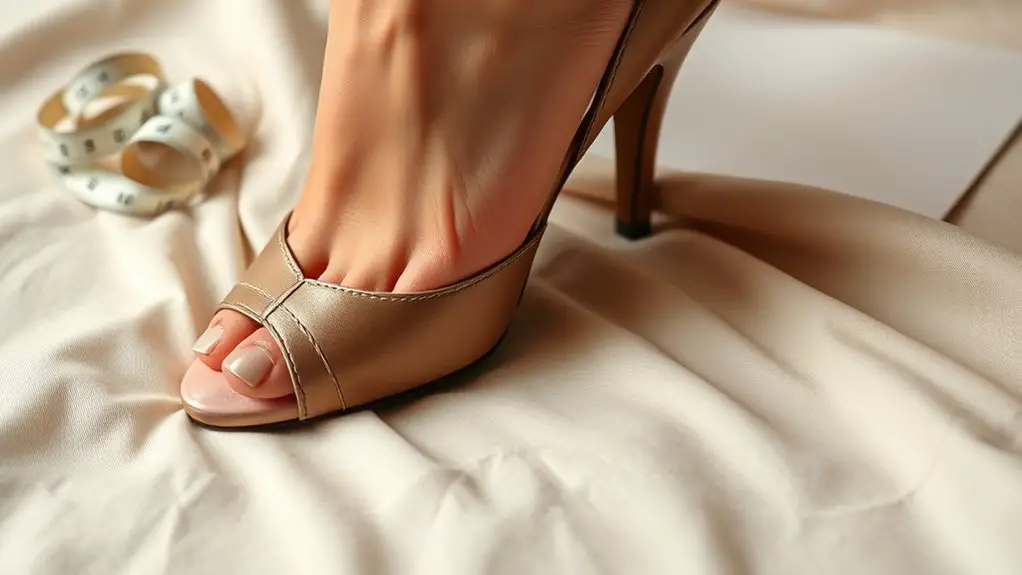
Choosing the right fit for your high heels is essential in preventing corns and calluses. Begin by ensuring accurate foot measurement; this involves measuring the length and width of your foot. Many footwear brands have their unique sizing, so always try on shoes before purchasing. Pay particular attention to heel height; excessively high heels can place undue pressure on the forefoot, leading to the development of painful corns. Ideally, select a heel height that allows for comfort and stability. Aim for a balance between style and practicality, as overly narrow or tight shoes can exacerbate friction and pressure points. Additionally, consider the shape of your foot; a shoe that conforms well to your foot’s contours will reduce the likelihood of developing calluses. By prioritizing fit, you can enhance your comfort while reducing the risk of foot ailments associated with high heels.
Opt for Quality Materials
When selecting high heels, opting for quality materials is essential for foot health. Breathable fabrics can help reduce moisture buildup, while supportive cushioning features provide necessary comfort and protection against pressure. Prioritizing these elements can greatly minimize the risk of developing corns and calluses.
Breathable Fabric Choices
Opting for breathable fabrics is essential for maintaining foot comfort, especially when wearing high heels. Choosing shoes made from moisture-wicking fabrics can effectively reduce sweat accumulation, which contributes to friction and the development of corns and calluses. Lightweight materials are also important; they prevent unnecessary pressure on your feet, allowing for better airflow. Look for shoes designed with breathable linings and uppers, as these features enhance ventilation, keeping your feet cooler and drier throughout the day. Additionally, consider styles that incorporate open-toe designs or perforated sections, which further promote breathability. By selecting high-quality, breathable fabrics, you can greatly decrease the risk of foot discomfort and skin issues associated with prolonged high heel usage.
Supportive Cushioning Features
Breathable fabrics lay the groundwork for comfort, but supportive cushioning features are equally important for preventing corns and calluses when wearing high heels. Opting for shoes that incorporate advanced cushioning technology can greatly enhance your foot’s comfort. Look for materials that provide adequate shock absorption, reducing pressure on specific areas of your feet. Additionally, proper arch support is essential; it helps distribute weight evenly and prevents excessive friction, which can lead to the formation of corns and calluses. When selecting high heels, prioritize designs that feature these supportive elements. Investing in quality footwear not only enhances your overall experience but also safeguards the health of your feet, ensuring you can enjoy wearing high heels without the unwanted side effects.
Limit Wear Time
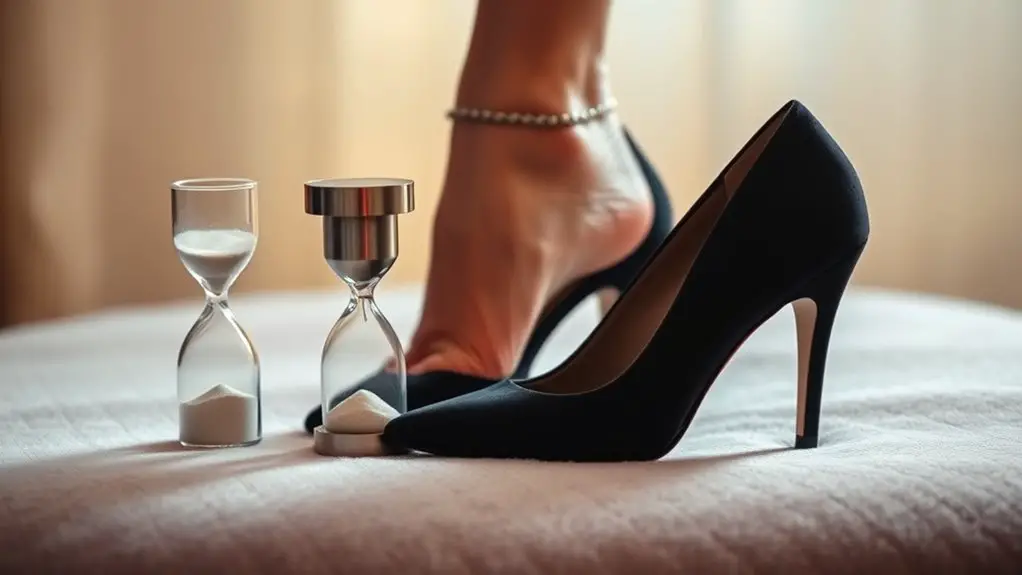
Although high heels can enhance your appearance, limiting wear time is essential to preventing corns and calluses. Prolonged use of high heels, particularly styles with considerable heel height, can alter your foot position, placing excessive pressure on specific areas. This increased pressure leads to the thickening of skin, resulting in corns and calluses.
To minimize the risk of developing these painful conditions, consider restricting your high heel wear to special occasions or brief periods. Aim for a maximum of two to three hours at a time. Additionally, alternate your footwear regularly to allow your feet to recover from the strain imposed by elevated heels. By consciously managing your wear time, you can greatly reduce the likelihood of developing these foot issues and maintain your overall foot health. Prioritizing comfort and foot care will help you enjoy the aesthetic benefits of high heels without compromising your well-being.
Use Cushioned Inserts
Using cushioned inserts is one effective way to alleviate pressure on your feet when wearing high heels. These inserts provide essential cushioning materials that help distribute weight evenly, reducing the risk of corns and calluses. Here’s why you should consider using them:
- Enhanced Comfort: Cushioned inserts provide immediate relief from foot fatigue.
- Arch Support: They offer necessary support to maintain proper foot alignment.
- Shock Absorption: Quality cushioning materials minimize the impact on your feet with each step.
- Custom Fit: Many inserts can be trimmed to fit your specific shoe size, ensuring maximum effectiveness.
Maintain Proper Foot Hygiene
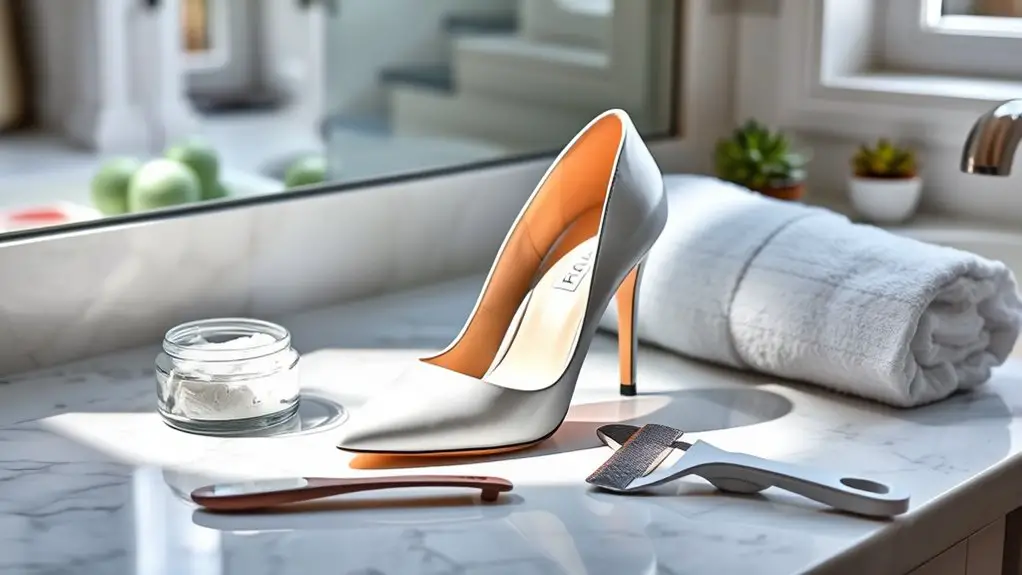
Maintaining proper foot hygiene is crucial for preventing corns and calluses, especially when frequently wearing high heels. Prioritizing foot cleanliness and nail care can greatly reduce the risk of these painful conditions. Begin by washing your feet daily with mild soap and warm water, ensuring you dry them thoroughly, particularly between the toes.
| Step | Description | Frequency |
|---|---|---|
| Washing | Clean feet with soap and water | Daily |
| Drying | Thoroughly dry feet | After washing |
| Nail care | Trim and file nails | Weekly |
| Moisturizing | Apply foot cream | Daily |
Regular nail care is crucial; keep your nails trimmed and filed to prevent ingrown nails and friction. Additionally, moisturizing helps maintain skin elasticity, reducing the likelihood of calluses forming. By following these practices, you can enhance foot health and comfort.
Rotate Your Footwear
To reduce the risk of developing corns and calluses, it is crucial to rotate your footwear regularly. Consider incorporating comfortable alternatives to high heels into your wardrobe and limit their usage to special occasions. This approach not only promotes foot health but also provides necessary relief from constant pressure.
Choose Comfortable Alternatives
While high heels may be a staple in many wardrobes, opting for comfortable alternatives can greatly reduce the risk of developing corns and calluses. By incorporating a variety of footwear options, you can support your foot health without sacrificing style. Consider the following alternatives:
- Fashionable flats that provide adequate cushioning and support.
- Stylish sneakers that offer breathability and flexibility.
- Loafers or slip-ons for easy wear and comfort throughout the day.
- Sandals with arch support to keep your feet cool and comfortable.
Limit High Heel Usage
Rotating your footwear can considerably reduce the strain high heels place on your feet. By varying your shoe choices, especially with different heel heights, you can alleviate pressure on specific areas, minimizing the risk of corns and calluses. It is crucial to incorporate supportive and cushioned shoes into your routine, allowing your feet to recover from the stress of elevated heels. Aim to wear high heels less frequently, reserving them for special occasions rather than daily use. This approach not only promotes better foot health but also encourages proper alignment and circulation. Remember, consistent rotation of your footwear is key in maintaining overall foot health and preventing the painful consequences associated with prolonged high heel wear.
Stretch Your Heels
Stretching your heels can greatly alleviate discomfort and prevent the formation of corns and calluses associated with high heels. Incorporating effective stretching techniques into your routine enhances heel flexibility, reducing pressure on sensitive areas.
Consider these essential stretching techniques:
- Calf Stretch: Stand facing a wall, place one foot back, and push your heel into the ground.
- Toe Touch: Bend forward from your hips, reaching for your toes while keeping your knees slightly bent.
- Ankle Circles: While seated, lift one foot and rotate your ankle in circles to improve mobility.
- Wall Stretch: Place your heel against a wall, leaning forward to stretch the Achilles tendon and heel.
Invest in Foot Care Products
Investing in foot care products is essential for maintaining comfort and preventing corns and calluses when wearing high heels. High-quality foot creams can provide critical hydration, helping to soften tough skin and reduce friction. Look for creams that contain ingredients like urea or salicylic acid, which can effectively exfoliate and moisturize the skin. Regular application will keep your feet supple, minimizing the risk of developing painful calluses.
Additionally, consider blister prevention products, such as blister pads or protective gels, to shield vulnerable areas of your feet from excessive rubbing. These products can be particularly beneficial during prolonged wear of high heels. By incorporating these foot care essentials into your routine, you’ll not only enhance comfort but also greatly lower the likelihood of developing corns and calluses. Prioritizing foot health is a proactive step towards enjoying your high heels without discomfort.
Pay Attention to Your Gait
One key factor in preventing corns and calluses while wearing high heels is your gait. A proper gait analysis can help identify your walking patterns, allowing you to adjust your stride and stance, which can greatly reduce pressure points on your feet.
To enhance your gait and minimize foot issues, consider the following:
- Foot Placement: Confirm your feet are aligned correctly during each step.
- Stride Length: Avoid overextending; a shorter stride can help maintain balance.
- Weight Distribution: Shift your weight evenly across your feet to reduce localized pressure.
- Core Engagement: Strengthen your core to promote a stable and balanced gait.
Seek Professional Advice
If you’re experiencing discomfort from high heels, consulting a podiatrist can provide valuable insights into your foot health. A professional can offer tailored footwear fitting recommendations to prevent corns and calluses. Taking this step can greatly improve your comfort and overall foot function.
Consult a Podiatrist
Consulting a podiatrist is essential for anyone frequently wearing high heels, especially if you’re experiencing discomfort or noticing the development of corns and calluses. Podiatrist consultations can provide valuable insights into your foot health and help prevent further issues.
During your appointment, you can expect to discuss:
- The specific areas of pain or discomfort
- Recommended treatments or therapies
- Proper foot care techniques
- The impact of high heels on your foot structure
A podiatrist’s expertise can guide you in managing any existing conditions and help develop a tailored strategy for maintaining peak foot health. Don’t hesitate to seek professional advice; early intervention can make a significant difference in your comfort and overall well-being.
Footwear Fitting Recommendations
After addressing any foot health concerns with a podiatrist, it’s important to focus on proper footwear fitting to further prevent corns and calluses. Accurate foot measurement is essential; always measure your feet at the end of the day when they’re most swollen. When selecting heels, consider the heel height—aim for a maximum of 2 inches to reduce pressure on your toes.
| Footwear Feature | Recommendation |
|---|---|
| Foot Measurement | Measure width and length |
| Heel Height | Limit to 2 inches max |
| Toe Box | Guarantee adequate space |
| Insole Support | Opt for cushioned insoles |
Following these guidelines will help you choose the right footwear, minimizing the risk of corns and calluses.
Frequently Asked Questions
Can Corns and Calluses Develop From Other Types of Shoes?
Yes, corns and calluses can develop from various shoe materials that don’t fit well, causing friction. When shoes don’t accommodate your foot anatomy properly, pressure points can lead to these painful skin conditions.
How Often Should I Replace My High Heels?
You should replace your high heels every 6-12 months, depending on their shoe lifespan and wear. Regularly evaluating heel comfort is essential, as worn-out shoes can lead to discomfort and foot health issues over time.
Are Certain Foot Shapes More Prone to Corns and Calluses?
If you’ve got flat feet, you might experience more friction, leading to corns. Similarly, those with high arches may develop calluses due to uneven pressure distribution. Both shapes greatly influence susceptibility to these foot conditions.
What Ingredients Should I Look for in Foot Care Products?
When selecting foot care products, look for moisturizing agents like glycerin and shea butter, along with exfoliating acids such as salicylic or glycolic acid. These ingredients help maintain skin hydration and promote effective cell turnover.
Can Corns and Calluses Lead to More Serious Foot Problems?
Corns and calluses, those rough patches on your skin, can lead to more serious foot problems if ignored. Treatment options may include proper footwear and moisturizers, as neglecting them can result in long-term effects like pain and infection.

